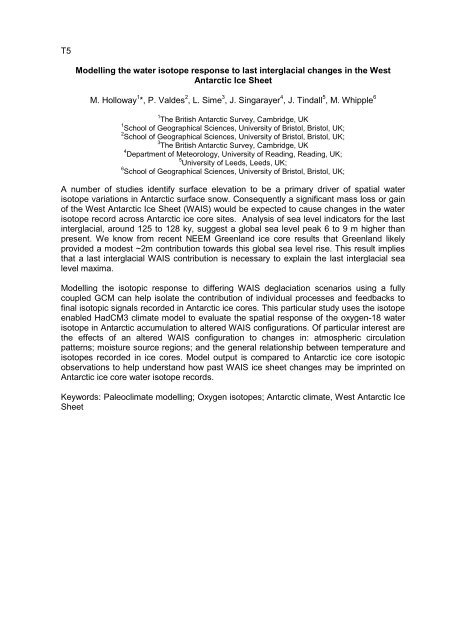The full programme book (PDF) - Royal Geographical Society
The full programme book (PDF) - Royal Geographical Society
The full programme book (PDF) - Royal Geographical Society
You also want an ePaper? Increase the reach of your titles
YUMPU automatically turns print PDFs into web optimized ePapers that Google loves.
T5<br />
Modelling the water isotope response to last interglacial changes in the West<br />
Antarctic Ice Sheet<br />
M. Holloway 1 *, P. Valdes 2 , L. Sime 3 , J. Singarayer 4 , J. Tindall 5 , M. Whipple 6<br />
1 <strong>The</strong> British Antarctic Survey, Cambridge, UK<br />
1 School of <strong>Geographical</strong> Sciences, University of Bristol, Bristol, UK;<br />
2 School of <strong>Geographical</strong> Sciences, University of Bristol, Bristol, UK;<br />
3 <strong>The</strong> British Antarctic Survey, Cambridge, UK<br />
4 Department of Meteorology, University of Reading, Reading, UK;<br />
5 University of Leeds, Leeds, UK;<br />
6 School of <strong>Geographical</strong> Sciences, University of Bristol, Bristol, UK;<br />
A number of studies identify surface elevation to be a primary driver of spatial water<br />
isotope variations in Antarctic surface snow. Consequently a significant mass loss or gain<br />
of the West Antarctic Ice Sheet (WAIS) would be expected to cause changes in the water<br />
isotope record across Antarctic ice core sites. Analysis of sea level indicators for the last<br />
interglacial, around 125 to 128 ky, suggest a global sea level peak 6 to 9 m higher than<br />
present. We know from recent NEEM Greenland ice core results that Greenland likely<br />
provided a modest ~2m contribution towards this global sea level rise. This result implies<br />
that a last interglacial WAIS contribution is necessary to explain the last interglacial sea<br />
level maxima.<br />
Modelling the isotopic response to differing WAIS deglaciation scenarios using a <strong>full</strong>y<br />
coupled GCM can help isolate the contribution of individual processes and feedbacks to<br />
final isotopic signals recorded in Antarctic ice cores. This particular study uses the isotope<br />
enabled HadCM3 climate model to evaluate the spatial response of the oxygen-18 water<br />
isotope in Antarctic accumulation to altered WAIS configurations. Of particular interest are<br />
the effects of an altered WAIS configuration to changes in: atmospheric circulation<br />
patterns; moisture source regions; and the general relationship between temperature and<br />
isotopes recorded in ice cores. Model output is compared to Antarctic ice core isotopic<br />
observations to help understand how past WAIS ice sheet changes may be imprinted on<br />
Antarctic ice core water isotope records.<br />
Keywords: Paleoclimate modelling; Oxygen isotopes; Antarctic climate, West Antarctic Ice<br />
Sheet
















